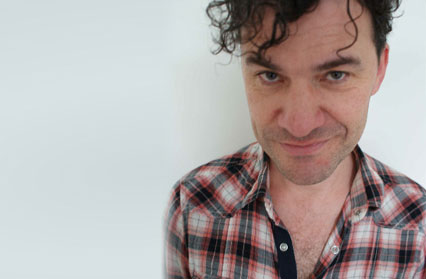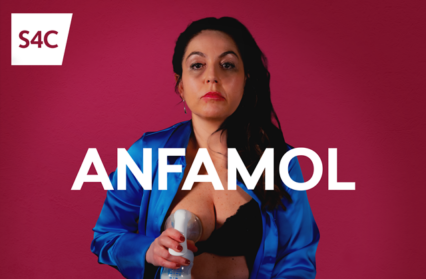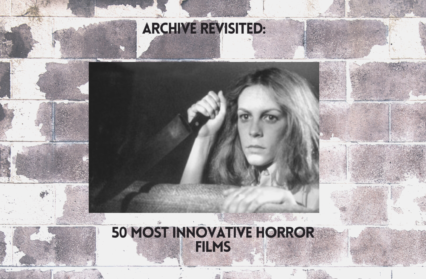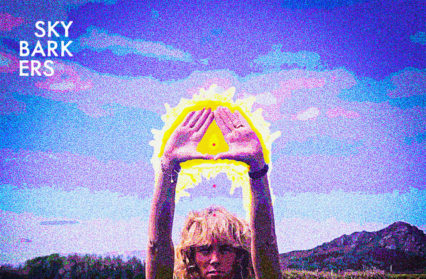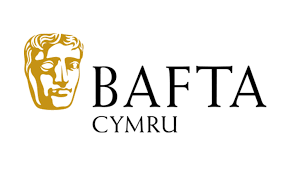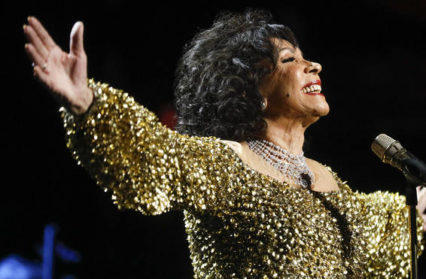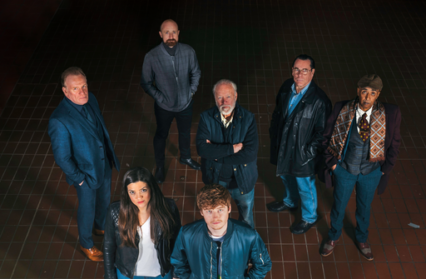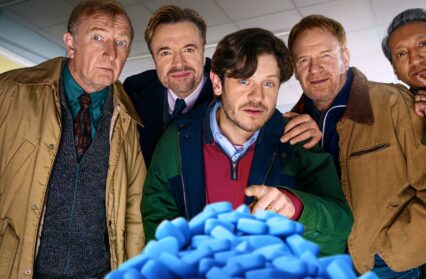When asked to define himself Mark Cousins responds with an emphatic ‘Film-maker’ – although his passion as a cineaste and critical analysis skills are clearly evident in his latest cinematic ‘essay’ A Story of Children and Film.
Cousins’ exploration of the relationship between childhood and the ‘youngest art form we have’ headlined the recent Wales One World Film Festival. Ahead of a screening at Chapter Arts Centre, he talked to our Managing Editor Phil Morris.
Phil Morris: Could we begin by discussing your childhood in Belfast during the 1970s? That must have been an anxious time and place to grow up?
Mark Cousins: Yes, well that was my reality, I was kind of in it like a fish is in water. It seemed normal. However, looking back, there was a degree of tension, my parents were in a mixed marriage – protestant Dad and catholic Mum. Maybe all children are doing this, but certainly I was looking for places to escape that tension. I remember the library at school, sitting looking at art books. I was a bad reader but I was very good with visuals. Sitting at those art books I felt happy and away from the world, and of course sitting in a cinema I felt happy and away from the world. I’m sure the first reason why I loved cinema was the building itself. This kind of a womb-like structure whereby the sound-proofing alone means that you don’t hear the buses passing outside – and it enables forgetting and it enables self-loss and it enables that process of giving yourself up to the screen. I always say that for me a cinema feels like sitting in winter looking at summer that kind of luminous holiday – movies felt like a holiday.
And it’s almost a disappointment to go out into the daylight afterwards isn’t it?
Yes, there is a sense of that. When you leave after a really good film you’re still wearing the glasses of that film, you’re still seeing the world through that lens. When you come back to reality it’s a kind of a comedown, or rather I would say a return to self, because if the film works well you kind of lose yourself and then you come back and it’s the disappointment of me.
I can relate to some of what you experienced, because I grew up in South Africa in the early eighties. I experienced that sense of general tension, around me, and I felt the same way as you about cinema. Cinema has a dualistic quality, it’s about reality but it’s also about escape and fantasy at the same time. How did that reality/fantasy dichotomy play out in your mind?
Well this is the fascination for me. This is why I’ve never understood the movies frankly, because how can you reconcile Lumiere and Melies, how can you reconcile Ken Loach and David Lynch? That ambiguity is so exciting it means that I as a filmmaker, if I point my camera at anything, if I point it at you, I’ve immediately got a snapshot of a reality, what you look like – and my job then is to find a distance from that, and to de-realitize that reality and find its dreamlike quality.
Is this a theme that emerges in A Story of Children and Film – this notion of de-realitizing reality and finding the poetics of childhood?
Yes I think so. When you’re trying to do something creative the first thing you’re trying to do is avoid banality. And what I try to do, at least, is try to find a poetics, which is the kind of musicality of the material, or the internal structure. With A Story of Children and Film I take a subject cinema, and another subject, childhood, and ask, ‘if I compare these two things what spark flies, what is their connection’? It would be easy to look at children only or cinema only and in some of my previous work I looked at cinema only. I’m lucky enough to know Paul Schrader, the writer of Taxi Driver and Raging Bull, and he told me that when he was writing Taxi Driver, that when he realised that Travis Bickle in that car is basically in an iron coffin. He thought voilà. Once Schrader realised he was really writing about a guy in an iron coffin he was off. The material had its own hum, its own resonance – that’s what I mean between reality and de-reality, it’s not that you want to make a fake portrait of something you want to find the hum within it.
I love how in Taxi Driver, Travis Bickle journeys from this man in the iron coffin to becoming this sort of Knight Errant – liberating the damsel in distress from the clutches of evil.
In that case it becomes a mythic thing. Paul Schrader’s great at that, being able to see the mythic structure within a story. And like so many people he read Joseph Campbell, I think a lot of people did and I certainly did as well. It was exciting to see that.
What are some of the films that remain with you from childhood?
During that period I didn’t even know there was an art-house cinema in Belfast. So I wasn’t seeing anything fancy at all, except on TV. I remember seeing Force of Evil – Do you remember the script of that film?
Yes, it’s all in blank verse if I remember correctly.
Blank verse, I was probably too young to understand why it was brilliant. Do you remember the ending of the film when he says ‘I went down and down and down,’ and you see him going down and down and down. I loved the rhythms and the poetics of that. I remember when I saw Stanley Kubrik’s film Eyes Wide Shut, which most people hated, it really reminded me of Force of Evil, the same repetition of lines again and again. Then I saw Touch of Evil – by Orson Welles – I now understand it’s about sex and race, I didn’t know that then I just knew it had this dark, night time feel. I also remember seeing An American in Paris with Gene Kelly, there must have been a series of his films on BBC2 – and the kind of uplift, that rapture you get in those musicals, for a boy to be seeing utopia and dystopia on television at the same time, how fantastic!
So you fell in love with cinema as a place, a venue, but you got into serious cinema via television?
Yes simply because I did not know. That’s why I’m passionate about making work that is accessible beyond the people in the know. I think Chapter Arts is a great place, but the taxi driver who brought me here from Bridgend has never been inside. He told me that he heard it was great in there – so is there some invisible barrier for people like him? And of course there is, it’s called class. That’s why I’m passionate about trying to make my work accessible. There’s a fancy phrase, I call it the ‘threshold aesthetics,’ that welcome – that thing that a building does, a book does, or a film does, that says this is for you, you’re welcome in here. I’ve done these amateury film festivals with Tilda Swinton and our key thing is always the welcome. We make sure that people feel it’s really for them. So we’re dancing outside and playing music and the pricing is £3.00 for adults and £2 for kids. And we just make cups of tea in the street and hand them out to get over the problem that I realise was in Belfast for me and my family.
Is this why you’re touring a season of films about childhood around Britain?
Well, yes, that Cinema of Childhood season you’re referring to isn’t formally as interesting as the work I did with Tilda Swinton. The season that’s coming up, and I’m very proud of it, is presented in established venues, but it’s not only for people who know a lot about cinema. One of the reasons I love cinema is that it is a grassroot art-form in a way.
You once said, ‘you have to know what you don’t know in order to do something good.’
Oh yes, it makes me sound like Donald Rumsfeld doesn’t it?
I think it’s the same point T.S. Eliot made in his essay ‘Tradition and the Individual Talent‘, the idea that you can’t be an original talent unless you have a deep knowledge of the traditions that have preceded you. So what did you learn during the making of A Story of Children and Film?
I think that it’s like the centrifugal imagination, you have to be interested in things outside yourself – basically the curious worldview – and I know that I have that. There are some films that I didn’t know, there is a Czech film called Long Live the Republic which is a masterpiece and I hadn’t seen it, there’s a Swedish film called Hugo and Josephine from the 60s which I hadn’t seen and it’s fantastic. There’s a brilliant Czech documentary which I’ve got an extract of called The Unseen and The Unseen is sort of what A Story of Children in Film is about. It’s trying to say we think we know about children’s films E.T., The Red Balloon etc., but beyond that open the magic curtain and there’s an Aladdin’s cave of treasures. That known and unknown thing is so interesting. I remember when I was writing the Story of Film that big book that I did. I remember thinking, are there any Ethiopian films? No there aren’t because I haven’t heard of them. Then I thought, maybe there are great Ethiopian films. And there were loads.
So that’s what’s brought you to the Wales One World Film Festival, because it has that transnational dimension?
Yeah, I’ve been a fan of Wales One World for a long time. I think what [David Gillam] does is very important and lots of people don’t get out of themselves you know? Some people are just interested in what’s immediately around them, and you have to connect. Wales One World connects with other cultures extremely well so that’s why I’m very happy to be here.
Particularly for the Welsh, because we are a minority culture to a certain extent. So it’s useful to have all these international films from other countries – that don’t get the attention they deserve – being shown here.
Absolutely, and you can find affinities of course with other places if you’re Welsh or Northern Irish. You can find unexpected affinities. If we acknowledge that despite our minority status within in the UK, we should also acknowledge that we were part of the colonial movement. That we forced our opinions on many people for many, many decades and so it’s right that we then open our ears and eyes and see what other people’s cultures are.
So how did you find a structure for this recent film? Your earlier work the Story of Film took a chronological approach, closely following your linear historical narrative. Did you need to take a different tack with A Story of Children in Film?
Yes, this is a good question. I’ve got a prop here to show you. I felt all my previous films have been road movies, I love the picaresque form – that loose road movie structure. But this time, I don’t usually write scripts as it were, so for this film, this was the script.
[At this point in the interview Cousins unfurled a large sheet of folded paper across the floor.]
I just drew the different themes like the child adventurer, the destructive child, the dreaming child, the child’s limited horizon and the dog with a bone. You can see how scribbled this is. Then I would write the names of films within these boxes so I knew what my themes were and all I had to do was find an order for them.
It looks to me like a multi-coloured mind map.
I was determined to make a non-linear film. And so usually on the edit suite wall you have a big timeline.
These are some of the children that appear in my film.
[At this point, he took out a stack of black and white photos. Each of the photos featured a close-up of a child from a film included in A Story of Children and Film.]
When I put these images out like this, suddenly I began to see the film. And thought what would this boy in the 400 Blows have to say to this boy from Great Expectations?
So you structured the film around these visual references rather than literary references?
Absolutely, I try to use words as well as I can, but I know for me it starts with the image. This child is bored with the world, she’s understood it and she wants more adventure. When I put these on the ground I realise that this child from Poland and this child from Iran were extremely similar. In terms of the structure the only visual reference on the wall was Paul Cezanne.
[He removes a copy of a painting by Cezanne and thrusts it in my hands.]
I’ve got a brilliant editor and I said you see the way there’s blue here and there’s grey here, and a salmon pink, and a kind of greeny, yellowy colour? Let’s try and think of these themes as colours in a Cezanne, a series of tones. When you’ve got no story it’s scary, what should keep people watching is the warmth and richness of tonality.
Did you discover any real surprises while gathering your source material?
There were big surprises in discovering connections between films. You think, ‘Wow, this girl from Senegal, she’s so similar to that girl from a completely different culture’. It was finding this connective tissue that was really surprising and exciting, you can feel it cooking, you can feel it coming to the boil, the film I mean.
Don’t you have to be careful about ‘universalising’ diverse cultural experiences like that?
When I was at university we were taught Edward Said’s Orientalism – this idea that you, somebody from the rich world, have spent too long making generalisations about other peoples. I bought all of that for a long time. But then when I started travelling, spent a lot of time in Iran or West Bengal or West Africa, I started to become less scared, less inhibited about making those connections, those generalisations. I think there’s a danger we can get too inhibited by Edward Said’s writings and those like him and we just get afraid of saying anything general and so we say we’re all separate. So many of the children that appear in my film go through the drama of attachment.
Think of Kes by Ken Loach, that little boy, Billy? He’s not really taught much about empathy or attachment at home or at school but he teaches himself through the friendship with that bird. Remember that scene in the school classroom where he’s holding out his arm and he almost closes his eyes and he imagines being with Kes? He has taught himself attachment, the key element that we call empathy, or whatever, that every human being needs to learn.
That’s also the central idea in E.T. The Extra-terrestrial…
This is why this approach works [pointing to the pictures on the floor] they are the same child. That’s why I’m not scared of making broad statements. I would say that all these children are in some way enslaved by their parents and teachers, albeit for good reasons. Every one of these children is straining at the leash wanting to jump the hedge, wanting to test the boundaries of what’s acceptable. In other words, they are slaves that want to get free in some way. I would say that’s pretty universal.
That’s certainly the theme of The White Balloon which I saw earlier this afternoon.
Isn’t it a great film?
Yes, that was a happy discovery. Its mode of storytelling is very interesting. As I was watching I kept thinking to myself – when is something dramatic going to happen? It took me half of the film’s length to let go of that expectation.
That little girl is just so stroppy, and she is determined to get what she wants.
I was so impressed by the film’s lack of sentimentality.
Oh that’s crucial to Iranian cinema. It’s not in their culture to idealise a child. Some cultures do, some people see purity in a child, innocence. I’ve never used the word innocent about a child.
I particularly like how the little girl in The White Balloon doesn’t seem to learn anything by the end of the film.
She learns fuck all.
Which is just like life, right? We’re taught by American cinema, in particular, all the time you’ll learn something. You’ll face all of these travails, you’ll get the golden statue and you will have learned something.
Yeah, I’m doing a film at the moment and my producers are talking about the learning thing. It’s one day in the life of someone, and they were going on about this, and I said – what did you learn today? Fuck all. For some Asian philosophies, like Buddhism, the central idea is to de-learn, almost to un-learn. To lose yourself and just notice there were two incredible rainbows over Cardiff this morning, notice the way the wind scars the sky. To learn nothing, that’s the great richness in Eastern philosophy.
That goes back to this notion that cinema has the power to de-realitize reality, which you talked about earlier?
I think it was Picasso that said all children are artists. He felt that we lose our creativity as we grow up for all sorts of reasons. We want to conform to tribes or we get self-conscious about who we are and what we look like. There’s so much truth in that.
When you’ve worked with young filmmakers, what kind of work do they produce?
I made a film called The First Movie. It took place in a village in Northern Iraq. It was my first film for the big screen. I went along and found that this bunch of kids had never seen a film on the big screen and I just thought ‘that’s amazing’. We sewed my bed sheets together and projected films. We showed them films for a couple of nights and then I gave them cameras but gave them zero tuition. I put the camera on the ground and put an arrow and we wrote in Kurdish ‘press this button’. And guess what? Somewhat to my annoyance they made better films than I had ever made and I’d been a filmmaker for 20 years at that point. I made them unafraid of the camera so that they saw it as an unprecious object. Therefore it became not about what the camera did, but more about using it to look through something. Later, Michael Moore gave me some Stanley Kubrick award because of that film.
Stanley Kubrick of all people!
I know he would have hated it! And I am, of course, not against education or inspiring or anything, but I knew that when I saw the footage from these kids there was something remarkable there that I could learn.
When we launch this upcoming Cinema of Childhood season, I’m going to have a child – a mini-me – walk on stage with adult me. The child is going to introduce the season that I programmed by saying, ‘it was created by him. I am him when he is a teenager. And I am bigger than him. He, in growing up, got small’.
Do you really believe that you’ve got small in some way?
I think I’ve fought against it. I’ve really fought against it. I’ve tried to be inventive and playful. Play is crucial for me. I’m really interested in Walter Benjamin’s idea of distraction, how you don’t try to focus solely on the task at hand, but just do something fun, improv, adlibbing, etc. Also I’ve never called myself a professional, I’ve always disliked that word. I’ve always called myself an amateur, an explorer, a constant apprentice, a learner. I’ve tried to avoid all that stuff that Picasso hated.
I only ask, because you appear to have retained that teenage passion for something you love, it doesn’t seem to have abated in any way.
No it hasn’t. But I suppose what I’m ashamed of is my ego. I’m thoroughly ashamed of that. I think the adult world has taught me to be ashamed of it. If a child sees a bit of pizza on a plate it’ll grab the pizza. Now, if I’m with my friends, I’ll say, ‘No no no, You have that bit of pizza’. You sort of hide your own desire in some way.
Just like the little girl in The White Balloon who wants that goldfish, she makes no apologies for her desires.
And what’s crucial for a child is to learn how all that works.
At that very moment, Cousins catches sight of two children cartwheeling in the spring sunshine outside the main entrance of Chapter Arts Centre. ‘I want to be doing that right now,’ says Cousins. The suggestion seems too ludicrous for me to take it as an insult. We both watch the children play for a few seconds, then agree that it’s a fitting point at which to end our discussion.
You can read David Anthony’s review of A Story of Children in Film here.
For more information on the Cinema of Childhood season go to: www.cinemaofchildhood.com


